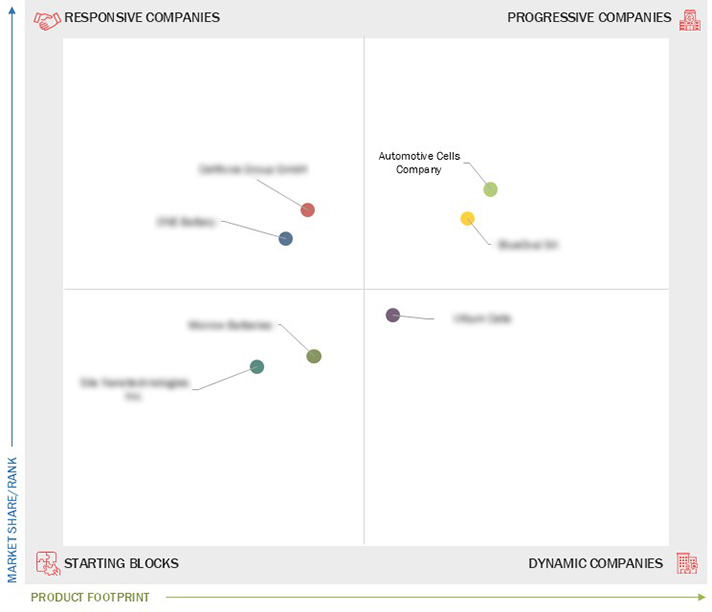Comparing 7 vendors in EV Battery Startups across 0 criteria.
The electric vehicle (EV) battery market has emerged as a critical component in the global push for cleaner transportation. This burgeoning industry is propelled by a convergence of technological innovations, regulatory frameworks, and evolving consumer preferences, all of which are striving to reduce the environmental impact of transportation. An EV battery is rechargeable to power BEVs, PHEVs, and HEVs. An EV battery comprises numerous small, individual cells arranged in series or parallel to achieve the desired voltage and capacity.
Market Leadership Quadrant
1.1 Study Objectives
1.2 Market Definition
1.3 Study Scope
1.3.1 Market Segmentation
1.3.2 Inclusions & Exclusions
1.4 Years Considered
1.5 Currency Considered
1.6 Unit Considered
1.7 Stakeholders
1.8 Summary of Changes
2.1 Introduction
2.2 Market Dynamics
2.2.1 Drivers
2.2.1.1 Rise in government incentives and OEM investments
2.2.1.2 Advancements in battery technologies
2.2.1.3 Government strategies to promote adoption of EVs
2.2.1.4 Declining prices of EV batteries
2.2.2 Restraints
2.2.2.1 Geopolitical instability and supply chain disruptions
2.2.2.2 Shortage of charging infrastructure in emerging economies
2.2.2.3 Emergence of alternative fuel options
2.2.3 Opportunities
2.2.3.1 Growth of BaaS in EV battery market’s boom
2.2.3.2 Development of innovative solid-state batteries
2.2.3.3 Advancements in ESSs
2.2.4 Challenges
2.2.4.1 High initial cost
2.2.4.2 Shortage of lithium
2.2.4.3 Safety concerns
2.2.4.4 Cost disparity between electric and conventional vehicles
2.3 Trends & Disruptions Impacting Customer Business
2.4 Rapid Development of Nevs to Drive Growth of EV Battery Market
2.5 Impact of AI on EV Battery Market
2.6 Ecosystem Analysis
2.7 Value Chain Analysis
2.8 Investment and Funding Scenario
2.9 Patent Analysis
2.10 Technology Analysis
2.10.1 Key Technologies
2.10.1.1 Lithium-ion and other battery chemistries
2.10.2 Complementary Technologies
2.10.2.1 Cell-to-pack (CTP) technology
2.10.3 Adjacent Technologies
2.10.3.1 Cell-to-chassis battery technology
2.11 HS Code: Lithium Cells and Batteries (850650)
2.11.1 Import Data
2.11.2 Export Data
2.12 Key Conferences & Events, 2025–2026
2.13 Oem Analysis
2.13.1 Initiatives Undertaken and Investments in Lithium by Battery
Manufacturers/OEMs
2.13.1.1 Lithium-ion battery cells (cathode type): OEMs and key
suppliers
2.14 Supplier Analysis
3.1 Introduction
3.2 Key Player Strategies/Right to Win, 2022–2024
3.3 Revenue Analysis
3.4 Market Share Analysis, 2024
3.5 EV Battery Market Share Trend Analysis
3.6 Company Valuation and Financial Metrics
3.7 Brand/Product Comparison
3.8 Company Evaluation Matrix: Startups/SMEs, 2024
3.8.1 Progressive Companies
3.8.2 Responsive Companies
3.8.3 Dynamic Companies
3.8.4 Starting Blocks
3.8.5 Competitive Benchmarking
3.8.5.1 List of startups/SMEs
3.8.5.2 Competitive benchmarking of startups/SMEs
3.9 Competitive Scenario
3.9.1 Product Launches/Developments
3.9.2 Deals
3.9.3 Expansion
3.9.4 Other Developments
4.1 AUTOMOTIVE CELLS COMPANY
4.1.1 Business overview
4.1.2 Products/Solutions/Services offered
4.1.3 Recent developments
4.2 BLUEOVAL SK
4.2.1 Business overview
4.2.2 Products/Solutions/Services offered
4.2.3 Recent developments
4.3 CELLFORCE GROUP GMBH
4.3.1 Business overview
4.3.2 Products/Solutions/Services offered
4.3.3 Recent developments
4.4 ULTIUM CELLS
4.4.1 Business overview
4.4.2 Products/Solutions/Services offered
4.4.3 Recent developments
4.5 ONE BATTERY
4.5.1 Business overview
4.5.2 Products/Solutions/Services offered
4.5.3 Recent developments
4.6 SILA NANOTECHNOLOGIES INC.
4.6.1 Business overview
4.6.2 Products/Solutions/Services offered
4.6.3 Recent developments
4.7 MORROW BATTERIES
4.7.1 Business overview
4.7.2 Products/Solutions/Services offered
4.7.3 Recent developments


 Ivalua
Ivalua
 Nov 2025
Nov 2025

